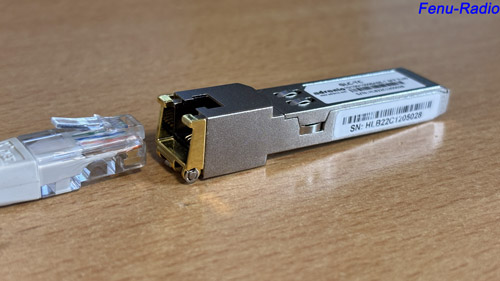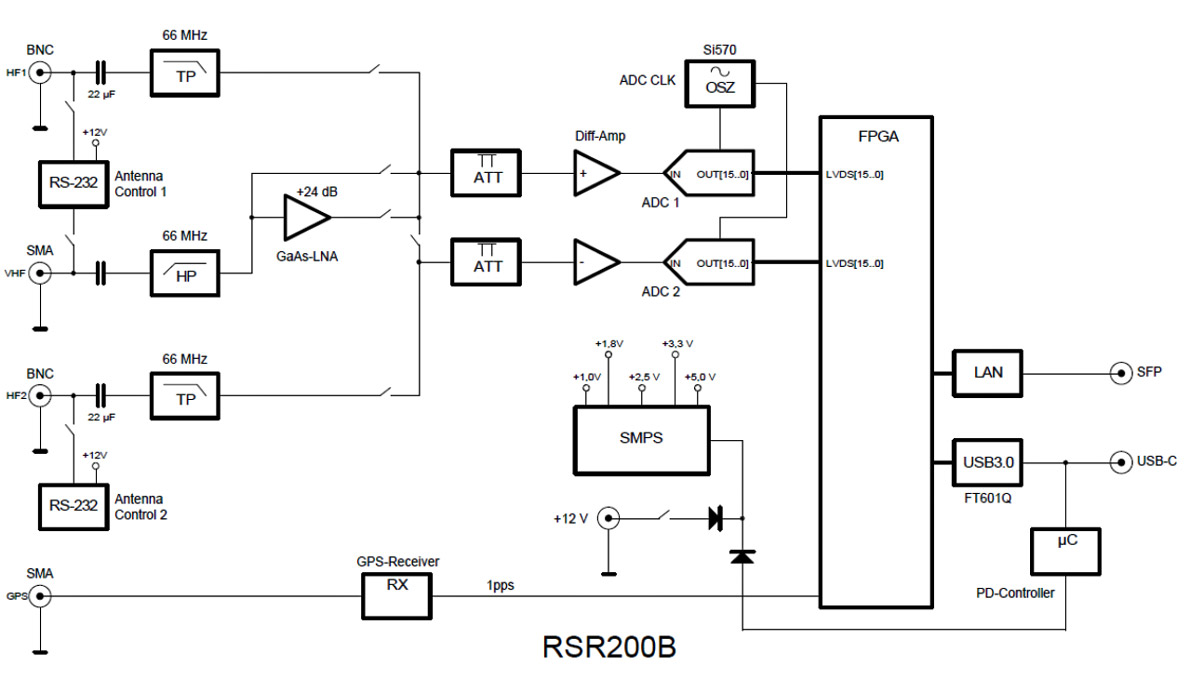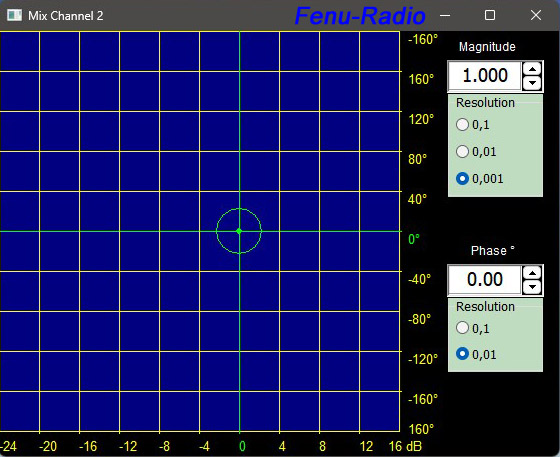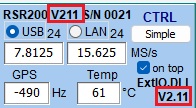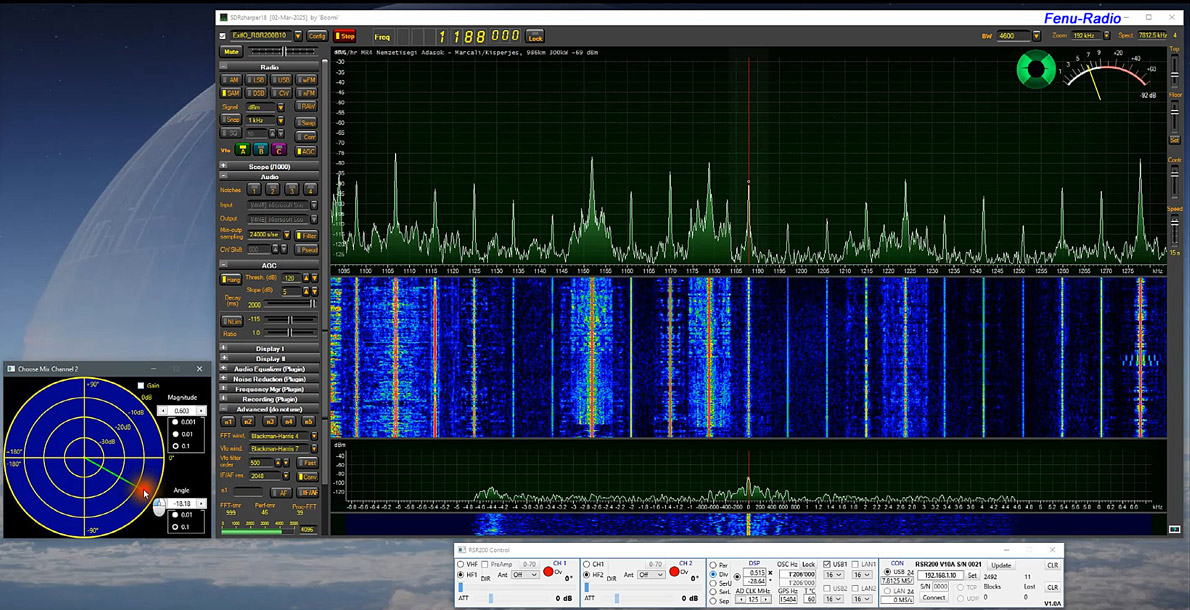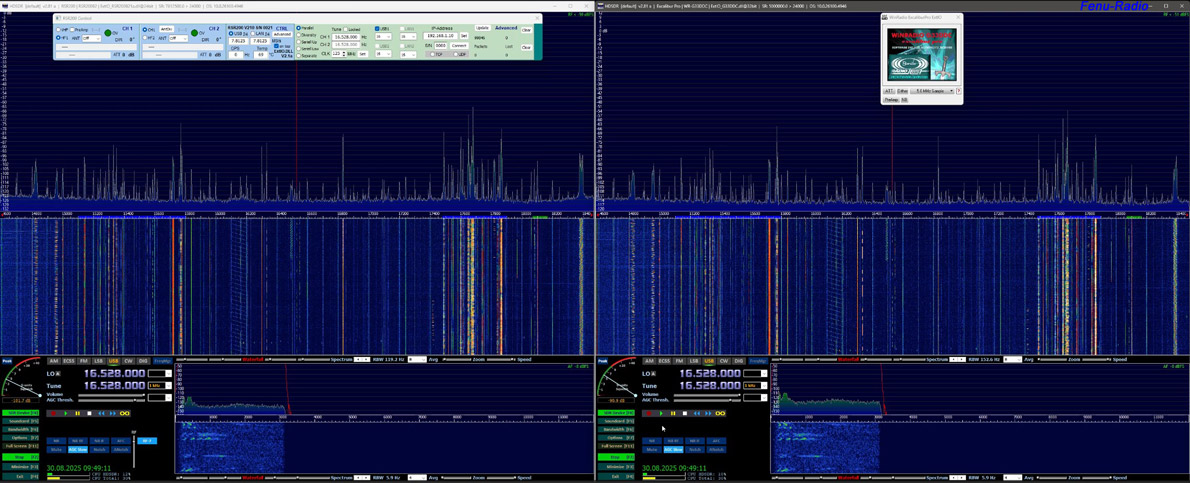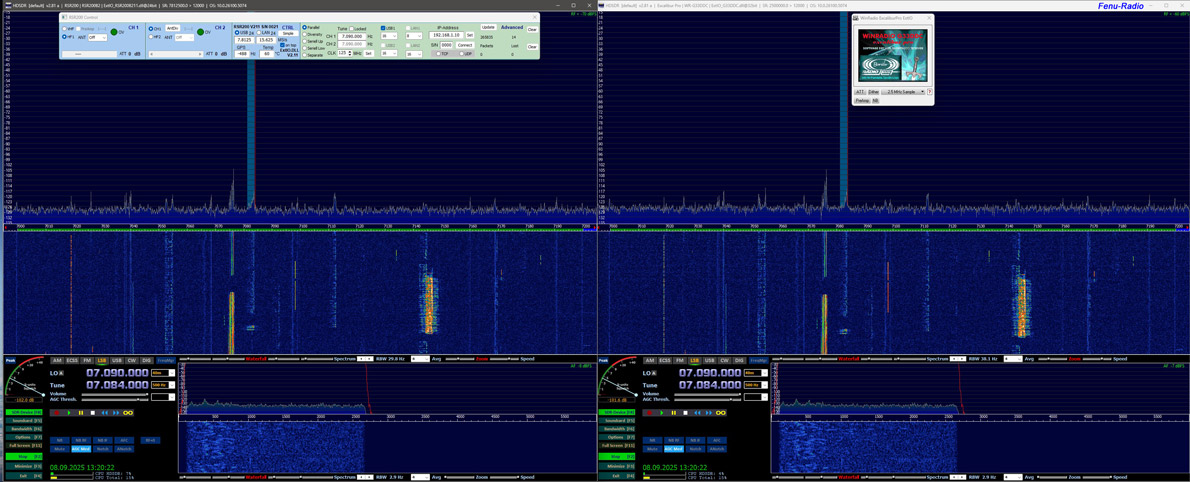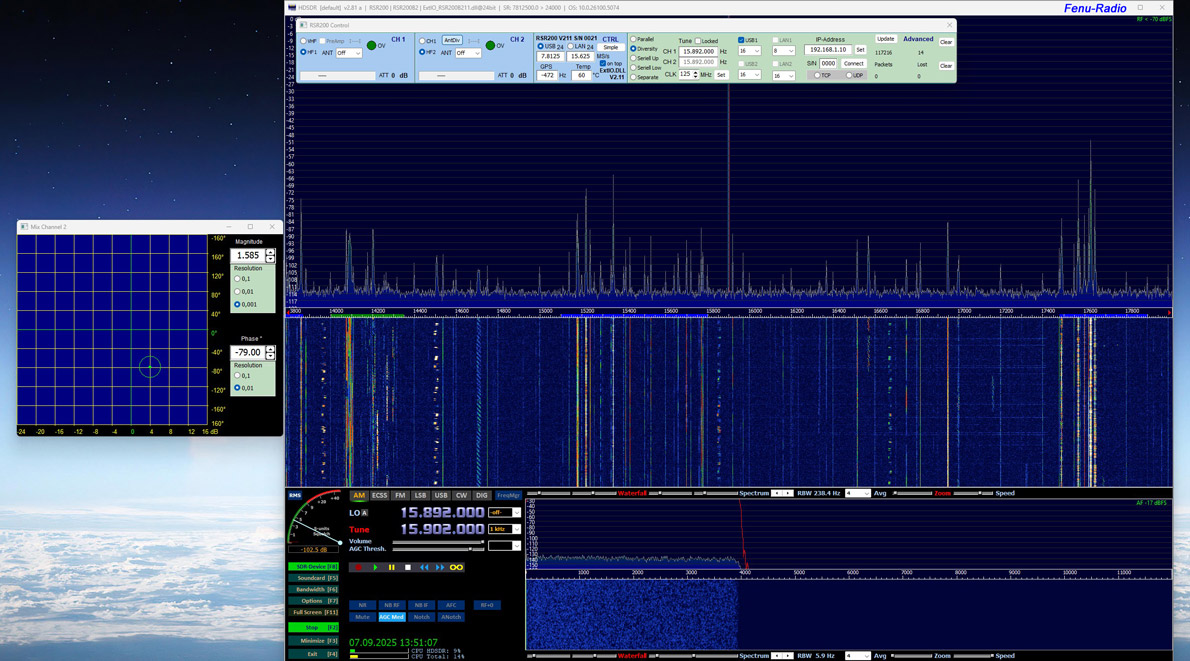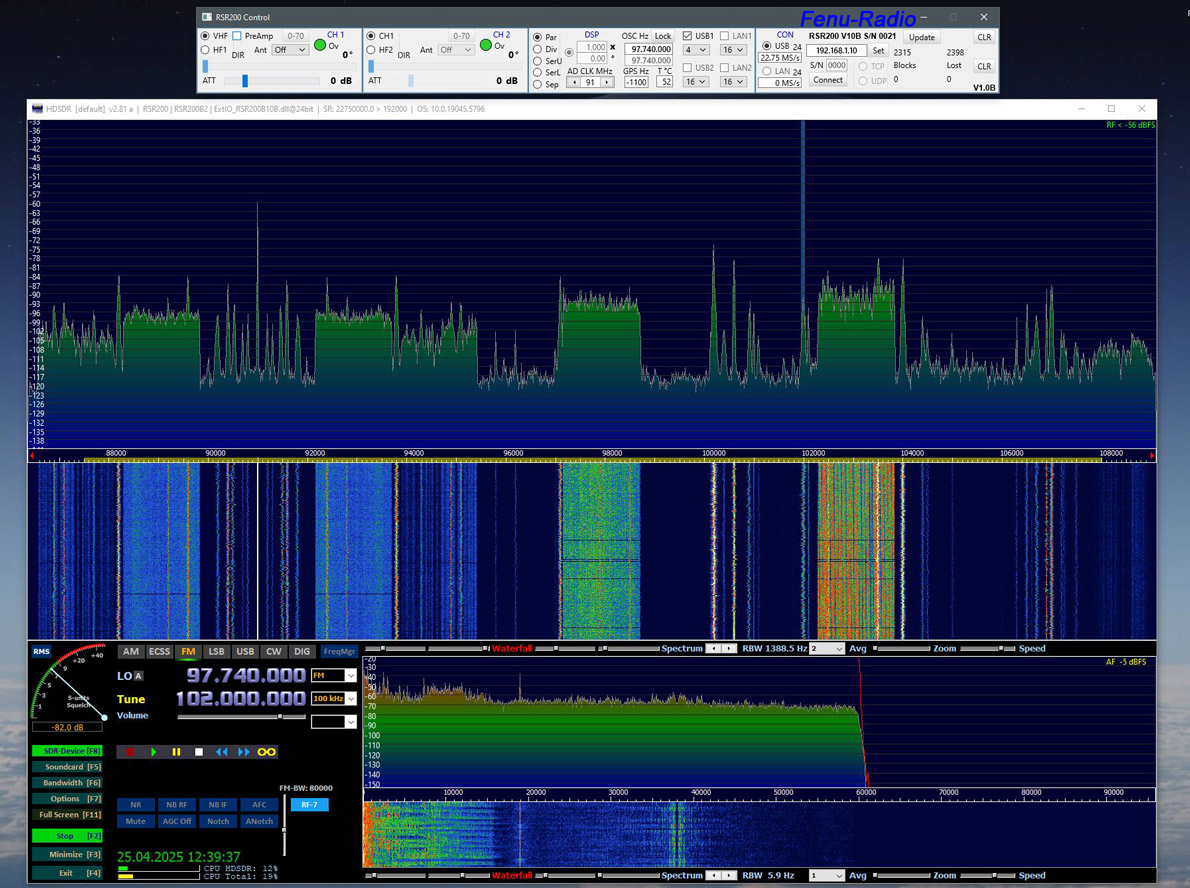|
Reuter RSR200B Reuter Elektronik,
known for its RDR receiver family, is expanding its range with a new
development: the RSR200B Software Defined Radio. The RSR200B is a
time-based direct sampling broadband SDR. The RDR receiver family
from Reuter all operate on a frequency basis. This makes the RSR200B
a new addition to the manufacturer's range.
Housing
and workmanship
The mysterious SFP1000 socket Put simply, the SFP1000 module allows the RSR200B to be operated either via a standard RJ45 Ethernet cable or a fiber optic cable. With the fiber optic version, a counterpart at the other end of the fiber optic cable is essential so that the light signal can be converted. This is unlikely to be used in the hobby world and is more likely to appeal to professional users.
Block diagram and functionality of the RSR200B The signals coming through HF1 and HF2 pass through a 66 MHz low-pass filter (LP). VHF has a 66 MHz high-pass filter (HP). These attenuate signals from other frequency ranges to prevent crossovers. An antenna control (RS-232) can be activated upstream, allowing active antennas such as the RLA4 and/or the RAP1 & RAP2 preselectors to be controlled remotely. Conventional active antennas with a 12V operating voltage can also be supplied via this control. The signals then pass through amplifiers and adjustable attenuators before reaching the ADCs. There, the signals are digitized and forwarded to the FPGA. The FPGA preprocesses the signals and then forwards them to the PC via the USB3 and/or LAN interface.
The operating software It would have been nice if Reuter Elektronik had provided its own operating software for the RSR200B. For a device in the $1,000 class, this would have been desirable. The manufacturer relies on existing freeware programs that allow ExtIO.dll connection, primarily HDSDR. There are other programs such as SoDiRa and SDRSharper. SoDiRa is too complicated and has program windows that are too small for modern high-resolution monitors. SDRSharper is an SDR# clone that is not very stable and crashes at higher bandwidths. However, it is perfectly usable for small bandwidths. Currently, HDSDR remains the only stable option. The control center for the RSR200B is the aforementioned ExtIO with the designation ExtIO_RSR200B2xx.dll. The program window is named “RSR200 Control.” This program connects the RSR200B to HDSDR. It offers many functions that HDSDR does not have integrated.
The RSR200 Control consists of two windows. The blue window contains the attenuation setting, antenna control, switchover to VHF operation, and the displays for GPS frequency correction, device temperature, and USB3 data flow display in MS/s. When activated, the “on top” function keeps the RSR200 Control always in the foreground. The green window contains advanced functions such as switching operating modes (diversity, etc.), LO tune frequency, ADC clock rates, sampling rate decimation, IP address for LAN operation, firmware update button, and an error counter. The operating modes
Parallel
Diversity Use the mouse to roughly find the appropriate position on the blue field. Using the numerical displays on the right, fine adjustments can be made using the mouse wheel or the buttons with the previously selected resolution. Antenna diversity largely corresponds to the signal phasing enabled by the Timewave ANC-4 device.
Seriell Up/Low
Separate Operation via USB3 and/or LAN The RSR200B is normally operated via the USB3 interface. This provides a maximum transfer rate of 5Gbit/s. The LAN interface transfers a maximum of 1000Mbit/s. This means that full broadband operation is not possible via LAN. The RSR200B can deliver data streams to both interfaces simultaneously. However, this is only possible with special evaluation software, which was not available at the time of testing. LAN would be interesting for remote operation. But again, no suitable software was available for this.
Installation of HDSDR and drivers During installation, I chose the wrong driver and, of course, it didn't work. I kept getting an error message. After consulting with Reuter Elektronik, it worked. My i7 computer is significantly older than 5 years! The driver for
older PCs is called: FTDI_USB. I recommend reading the operating instructions carefully!
Firmware update for the RSR200B
Working with the RSR200B First, you have to get used to HDSDR. I use a 34" high-resolution monitor, on which the sliders for spectrum, waterfall, etc. in HDSDR are displayed very small. This means you have to be very precise with the mouse. But after a while, you get used to it. You also have to mentally sort through and understand the many functions offered by RSR200 Control. This is because there are functions and operating modes that the average person is not familiar with and does not understand right away. Only advanced users, such as radio amateurs or professionals who are well versed in SDR technology, can interpret them correctly. I mainly dealt with the operating modes that were relevant to me: parallel and diversity. The other operating modes were either incomprehensible to me or unusable due to a lack of suitable software. The reception As a comparison receiver, I used the Winradio G33DDC Excalibur Pro, which I still consider to be one of the best SDRs. There is also an Extio.dll for this receiver that works well with HDSDR. To create identical conditions, the HDSDR S-meter had to be calibrated so that both competitors displayed a realistic signal level. For this, I used a signal generator and calibrated both to -73dBm (S9). Volume and threshold were also set to the same values. The following
antennas were used: I received the
RSR200B at the beginning of March 2025. Since then, I have been
working with the device almost daily and have been able to
contribute a few improvements to the RSR200 Control. Reuter
Elektronik was very user-friendly and implemented the ideas and
suggestions in a very short time. As every night, there is a lot going on on medium wave. Numerous stations, often broadcasting on the same frequency, interfere with each other. A real jumble of stations. The perfect scenario for trying out diversity reception. To be able to use diversity, the antennas should ideally be at least one wavelength apart from each other in order to achieve some diversity gain. Unfortunately, very few of us have that much space available in our front yards. For diversity reception on medium wave, the antennas would have to be at least 160m apart. But with a little patience and luck, it also works if the antennas are only a few meters apart. With SDRSharper and an early version of RSR200 Control, I managed to separate two stations on the same frequency. After a bit of experimentation, I was able to separate “Radio Studio X” from Italy and “Radio Payam” from Iran quite well. You can hear this very clearly in the YouTube video below. This was not possible with the G33DDC because it does not support diversity. Otherwise, reception performance on medium wave was excellent. No intermodulation was detected. Click on the image to watch the video on YouTube.
Click on the image to watch the video on YouTube. Click on the image to watch the video on YouTube. Click on the image to enlarge.
FM reception The RSR200B can
receive frequencies up to 150 MHz. It has a separate “VHF” antenna
connection for this purpose. Below: The FM band littered with DAB+ rollovers.
Conclusion: The RSR200B is a
top shortwave receiver that easily beats my reference receiver in
terms of noise and sensitivity. It supports features such as antenna
diversity, which makes hunting for hidden stations even more
interesting. Not only that, but it also offers features that could
make the RSR200B appealing even to professional users. Nevertheless, the RSR200B offers very high-quality reception. Posted: September
12, 2025
|

.jpg)
.jpg)
.jpg)
.jpg)

.jpg)

.jpg)
.jpg)

.jpg)
